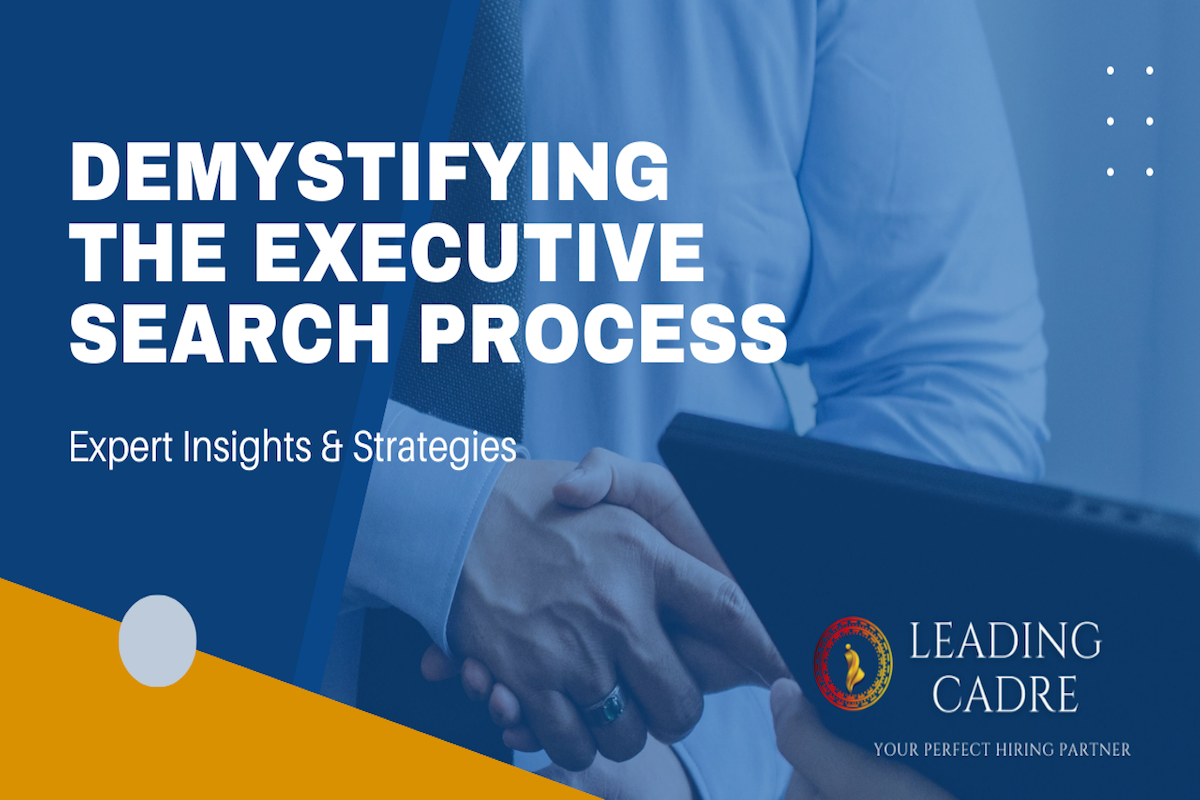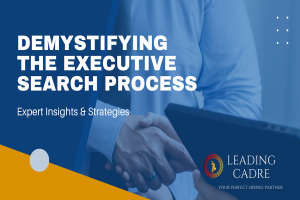Introduction:
Hey there, ever wondered how organizations find those amazing leaders who steer them to success? It’s like a treasure hunt for the perfect fit – someone who not only has the skills but also the spark to make things happen. We’re here to unravel the mystery behind this Recruitment process called “executive search.” Think of it as your guide to understanding how top-notch leaders are discovered and how you can be part of this exciting journey. So, let’s dive in and demystify this world of finding and attracting top talent!
What is Executive Search
Executive search, a specialized approach within the realm of talent acquisition, is the strategic process of identifying, attracting, and securing top-tier leadership talent for senior-level positions within organizations.
Unlike conventional recruitment, executive search is tailored to the unique demands of leadership roles, where candidates are not merely selected based on qualifications, but are meticulously evaluated for their strategic acumen, cultural fit, and transformative potential. This process involves a collaborative partnership between executive search firms and clients, delving deep into the organization’s objectives and culture to pinpoint the ideal candidate profile. Leveraging industry insights and a network of connections, executive search experts navigate through both active and passive candidate pools, reaching out with personalized engagement strategies. This intricate process ensures that the selected leaders are not only equipped with the necessary skills but possess the vision and leadership qualities to drive the organization’s success.
The Difference: Executive Search vs. Traditional Recruitment:
At its core, the contrast between executive search and traditional recruitment lies in their targeted scope and strategic methodology. While traditional recruitment covers a broad spectrum of positions, executive search stands apart by centering its efforts on senior-level roles, necessitating a nuanced and specialized approach.
Unlike conventional methods, executive search goes beyond evaluating qualifications, placing a spotlight on leadership qualities, cultural compatibility, and strategic thinking. This meticulous process ensures that candidates are not just well-suited for the position, but are also poised to drive substantial organizational impact
In simple terms, executive search is like a focused journey to find the best leaders for important roles. These leaders are carefully chosen to match the needs of high-level positions, and their appointments play a big role in shaping the success of the organization down the line.

The Significance of Executive Search: Unveiling Leadership Excellence:
The importance of executive search becomes evident when we consider its role in securing forward-thinking leaders. These visionary individuals are crucial for an organization’s growth and progress, as they bring fresh perspectives and innovative strategies to the table. Executive leaders, by virtue of their expertise and strategic thinking, play a pivotal role in shaping the success of the organization. They not only lead teams effectively but also influence the entire business landscape. Through their adept decision-making and strong leadership, executive leaders pave the way for innovation, expansion, and sustainable growth. In this context, executive search emerges as a cornerstone in identifying and bringing on board these transformational leaders, ensuring an organization’s enduring excellence and progress.
Navigating the Executive Search Journey: Step-by-Step Guide:
In the upcoming section, we will provide a clear and concise overview of the entire executive search process, guiding you through each step with simplified explanations for easy understanding.
Step 1: Executive Search Partner & Client Collaboration and Needs Assessment:
At the outset of the executive search process, Step 1 involves a close partnership of the executive search consultant with the client to grasp their aspirations, company culture, and specific needs. This deep understanding forms the foundation for the entire journey, ensuring that the search aligns with the client’s strategic vision. This phase is marked by collaboration, where the collective expertise of both parties contributes to shaping the path forward. By delving into the client’s objectives and intricacies, this step lays the groundwork for a successful executive search, tailored precisely to the client’s unique requirements and ambitions.
Step 2: Research and Market Mapping: Finding the Hidden Gems:
Moving into Step 2, we delve into in-depth research and market mapping, a critical phase in the executive search journey. Here, the focus is on unearthing potential candidates who may not be immediately visible. Thorough research enables us to identify these hidden gems, individuals whose skills and expertise perfectly align with the client’s needs. Beyond candidate discovery, this step also involves recognizing prevailing talent trends and gaining insights into industry dynamics. This broader perspective ensures that the tailored search remains attuned to the ever-evolving demands of the market, paving the way for a successful match between candidates and organizational aspirations.
Step 3: Candidate Identification and Outreach: The Art of Engagement:
Advancing to Step 3, we delve into the intricate art of candidate identification and outreach. This phase involves a dual approach, encompassing both active candidates actively seeking opportunities through job boards or other channels and those who may not be actively looking but possess exceptional potential. It’s about striking the right balance and fostering genuine engagement. Crafting outreach messages plays a pivotal role; they need to resonate with candidates’ aspirations and pique their interest. It’s not just about presenting opportunities; it’s about creating connections and initiating meaningful conversations. By employing personalized and compelling outreach techniques, we ensure that candidates feel valued and enthusiastic about exploring the possibilities, laying the groundwork for a promising partnership.
Step 4: Assessment of Candidate and Evaluation: Beyond Qualifications:
Advancing to Step 4, we delve into the critical phase of candidate assessment and evaluation, which goes beyond mere qualifications. This multifaceted process involves a comprehensive evaluation of suitable candidates, encompassing a spectrum of attributes crucial for executive roles. It’s not solely about technical skills; it’s about assessing leadership prowess, strategic acumen, and the potential to align seamlessly with the organization’s culture. By focusing on these elements, we ensure that the qualified candidates shortlisted possess the innate qualities required to drive organizational success. This step is about identifying the individuals who possess the capabilities to not only excel but also contribute to shaping the organization’s trajectory towards excellence.
Step 5: Client-Candidate Alignment: Ensuring Mutual Success:
Transitioning to Step 5, we embark on the essential task of aligning client and candidate expectations to ensure a harmonious partnership. This phase centers around clear communication and shared understanding. It’s about making sure that both the client’s vision and the candidate’s aspirations are in sync, setting the stage for a mutually beneficial collaboration. Beyond the immediate match, we also consider the importance of long-term compatibility. The goal isn’t just to fill a role but to forge a lasting connection that fuels enduring success. By establishing alignment and compatibility, we lay a solid foundation for a partnership that not only thrives in the present but also evolves and flourishes over time, making way for remarkable achievements.
Step 6: Offer Negotiation and Onboarding Support: Sealing the Deal:
Moving into Step 6, we venture into the crucial phase of offer negotiation and onboarding support, which plays a pivotal role in sealing the deal. Here, our focus extends beyond identifying the right fit to ensure a smooth transition. Facilitating offer negotiations involves harmonizing the expectations of both the client and the candidate, bridging any gaps to reach an agreement that satisfies all parties. Equally essential is the provision of onboarding support, which ensures that the transition into the new role is seamless and effective. By assisting both clients and candidates throughout this process, we lay the groundwork for a successful partnership right from the beginning, setting the stage for growth and accomplishment.
Crafting an Irresistible Magnet: Essentials for Attracting Top-Level Talent
Navigating the realm of attracting top-level talent demands a strategic approach that aligns with the distinct requirements of executives. Beyond partnering with an executive search firm, organizations must orchestrate a symphony of elements to captivate and engage visionary leaders. From cultivating a magnetic employer brand to tailoring compensation packages and opportunities for growth, each facet plays a pivotal role in drawing in the crème de la crème of the talent pool. In this pursuit, understanding the nuanced desires of top-level candidates and addressing their expectations becomes a paramount priority, ensuring a convergence of aspirations and organizational success.
Here are essential points for employers to focus on when aiming to attract and engage high-caliber candidates:
1. Strong Employer Branding:
- Develop a compelling employer brand that highlights the organization’s values, culture, and achievements.
- Showcase the organization’s reputation, industry leadership, and impact in order to capture candidates’ attention.
2. Clear Value Proposition:
- Articulate the unique value proposition that the organization offers to top-level candidates.
- Highlight how their skills and expertise align with the company’s strategic direction and vision.
3. Thoughtful Job Descriptions:
- Craft job descriptions that are comprehensive, engaging, and transparent about the role’s responsibilities and expectations.
- Clearly communicate the executive’s role in driving business growth and innovation.
4. Competitive Compensation Packages:
- Offer a compensation package that reflects the seniority of the role and is competitive within the industry.
- Consider not only base salary but also bonuses, equity, and benefits that resonate with top-tier candidates.
5. Professional Growth and Development:
- Emphasize the opportunities for skill enhancement, leadership development, and continuous learning.
- Outline how the organization invests in its executives’ growth and supports their career trajectory.
6. Flexibility and Work-Life Balance:
- Recognize the importance of a healthy work-life balance for high-level professionals.
- Demonstrate flexibility in work arrangements and a commitment to supporting their personal commitments.
7. Autonomy and Decision-Making Authority:
- Showcase the level of autonomy and decision-making authority that comes with the executive position.
- Highlight how the role enables the candidate to drive impactful changes and shape the organization’s future.
8. Alignment with Organizational Vision:
- Illustrate how the executive’s strategic thinking aligns with the company’s long-term vision.
- Emphasize the candidate’s potential to contribute to the organization’s growth and success.
9. Impactful Projects and Challenges:
- Discuss current or upcoming projects that will allow the executive to make a significant impact.
- Demonstrate the exciting challenges that the role will entail, appealing to candidates’ desire for meaningful work.
10. Transparent Communication:
- Establish open and honest communication from the beginning of the recruitment process.
- Be transparent about the organization’s goals, challenges, and expectations to build trust.
11. Networking and Industry Involvement:
- Showcase the organization’s involvement in industry events, associations, and networks.
- Highlight opportunities for the executive to connect with peers and contribute to industry advancement.
12. Customized Approach:
- Recognize that top-level candidates are unique, and their requirements may vary.
- Tailor the recruitment approach to address individual preferences and career aspirations.
By addressing these essentials, organizations can create a compelling and attractive environment for top-level candidates. Acknowledging the unique needs and desires of high-caliber executives enhances the chances of successful recruitment and building strong leadership teams.
Conclusion:
As we conclude this journey through the world of executive search, we’ve unveiled the secret behind finding exceptional leaders who light up organizations. Think of it as a puzzle coming together, piece by piece, until the perfect fit emerges. It’s not just about finding someone with the right skills, but also about finding someone who fits the culture, vision, and aspirations of the organization.
Working with an executive search firm is like having a skilled guide by your side, leading you through uncharted territory. It’s about collaborating closely to understand what you need, searching high and low for hidden gems, and reaching out to potential leaders in a way that sparks genuine interest.
But it doesn’t stop there. We’ve also explored how organizations can be magnets for top-level talent. It’s about being clear about what you offer, showing how someone’s skills can make a real impact, and creating an environment where they can thrive.
So, as you embark on your journey to find those game-changing leaders or to be one yourself, remember that executive search is more than just a process – it’s a partnership, a discovery, and a journey toward growth and success. By demystifying the process and understanding what it takes to attract top talent, you’re equipped with the tools to navigate this exciting path.
FAQ’S
When it comes to the executive search process, there are a number of questions that potential candidates may have. To help clarify this often complicated and mysterious process, here are some frequently asked questions (FAQs) that can provide valuable insight into what you need to know.
Q1: How can I use the insights from this article in my organization?
A1: You can use the insights to understand the importance of finding the right leaders, improving your recruitment approach, and creating an attractive environment for top-level talent.
Q2: How are Executive Search agencies paid or compensated?
A2: Executive search recruiters commonly operate under a retained model, which differs from contingency recruitment. In this approach, recruiters receive an initial fee upfront, followed by further payment upon a successful placement. It’s also common to encounter a fee structure during the shortlist phase.
The specific details of the compensation arrangement can also vary and are usually discussed and agreed upon between the organization and the recruiter before the search process begins to ensure there is no bad hire
Q3: What Jobs or roles do Executive Search specialists recruit for?
A3: Executive search consultants recruit for a wide range of senior-level roles, typically ranging from CEO and C-suite positions to VP-level and manager-level roles. They may also recruit for niche executive-level positions such as Board members, Chief Technology Officers, Chief Financial Officers, Chief Operating Officers, Chief Marketing Officers, and other specialty roles that require specific technical skills, leadership abilities, or qualifications.
Q4: What is the necessity to use an Executive Search Agency?
A4: The use of an executive search agency is necessary in today’s competitive and fast-paced business environment. Executive Recruiters are specialized firms that help organizations to identify, attract and hire top talent that can help them take their businesses to the next level.
Recruiting an executive is a difficult process that requires time, effort, and expertise. Executive search firms provide a valuable service to employers by helping them identify the perfect candidates for their leadership roles. The Executive Recruiters work closely with employers to understand their internal culture and needs, develop job profiles that accurately reflect the desired qualifications and experience of successful candidates in those roles, source relevant candidates, and facilitate the interview process
Q5: What is the difference between Executive Search and Head Hunting?
A5: Executive search and headhunting are two distinct processes. Executive search is a term used to describe the process of finding an executive-level candidate for a specific role in an organization. This recruitment process includes conducting research, interviewing potential candidates, and using resources from internal networks or external recruitment agencies. Headhunting, on the other hand, is a more direct approach to sourcing candidates and involves actively approaching a pre-defined list of potential candidates from competitors without advertising a role.
Q6: As a potential candidate for an executive or C-Suite role, how do you ensure you are found by an Executive Search Consultant?
A6: In today’s competitive job market, finding a C-suite role can be a daunting task. As a potential candidate for an executive or C-Suite role, it is important to ensure that you stand out from the crowd and are found by an Executive Recruiter. Here are six tips to help you get noticed by an Executive Search Consultant:
1) Create a comprehensive online presence that reflects your professional background and experience.
2) Network with professionals in your industry to establish connections
3) Join professional associations and attend events and conferences related to your field
4) Utilize social media platforms, such as LinkedIn, to maximize visibility
5) Be active on job boards or recruitment sites
6) Take advantage of the resources offered by executive search firms such as career assessments, workshops, and webinars.




